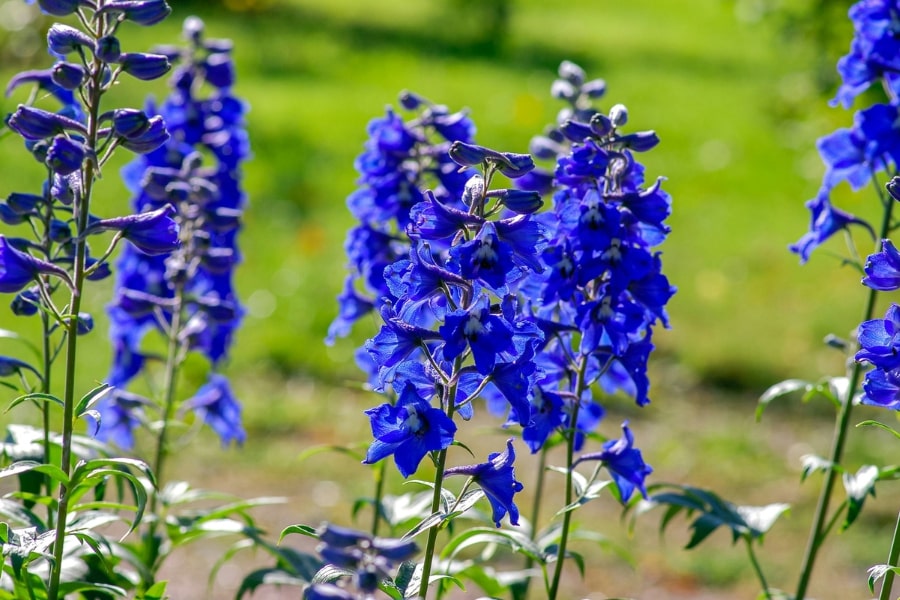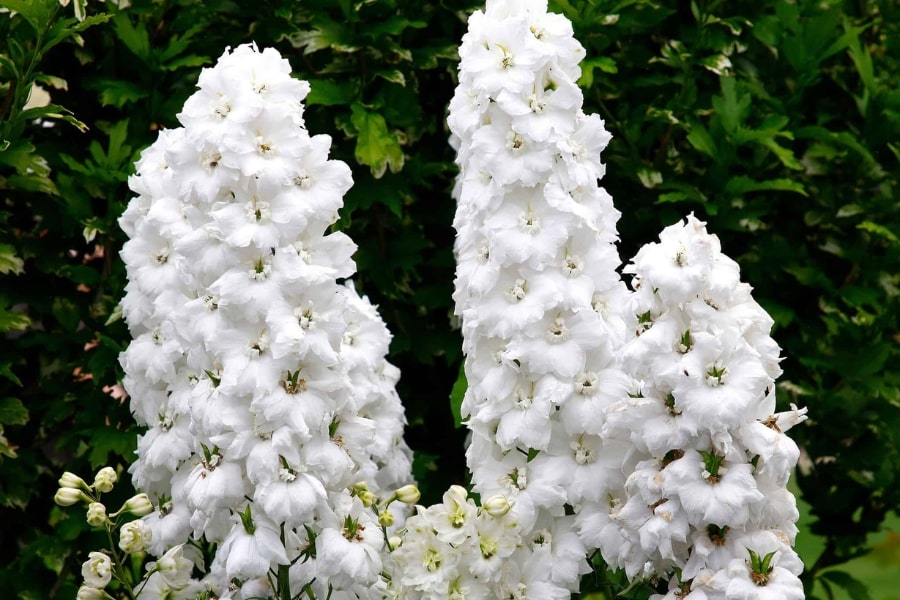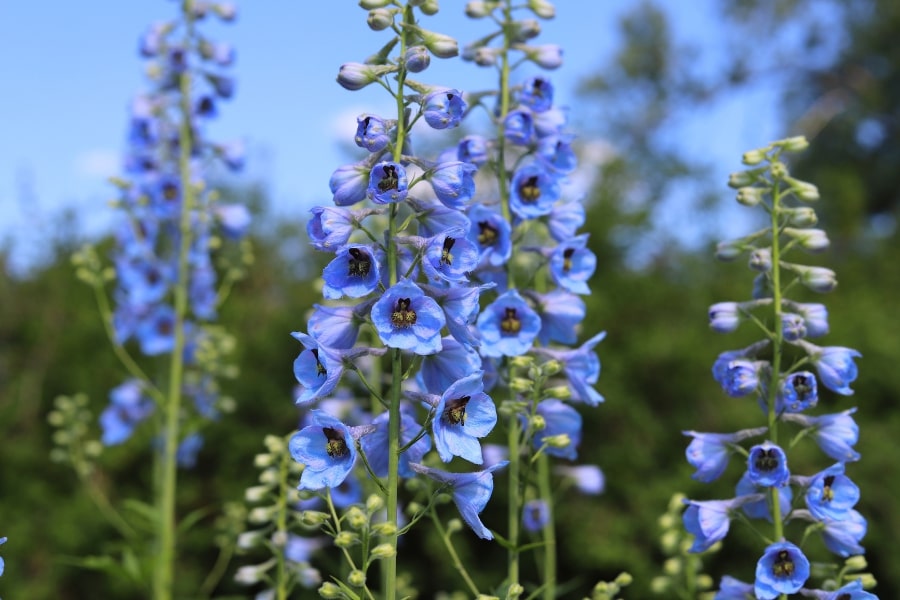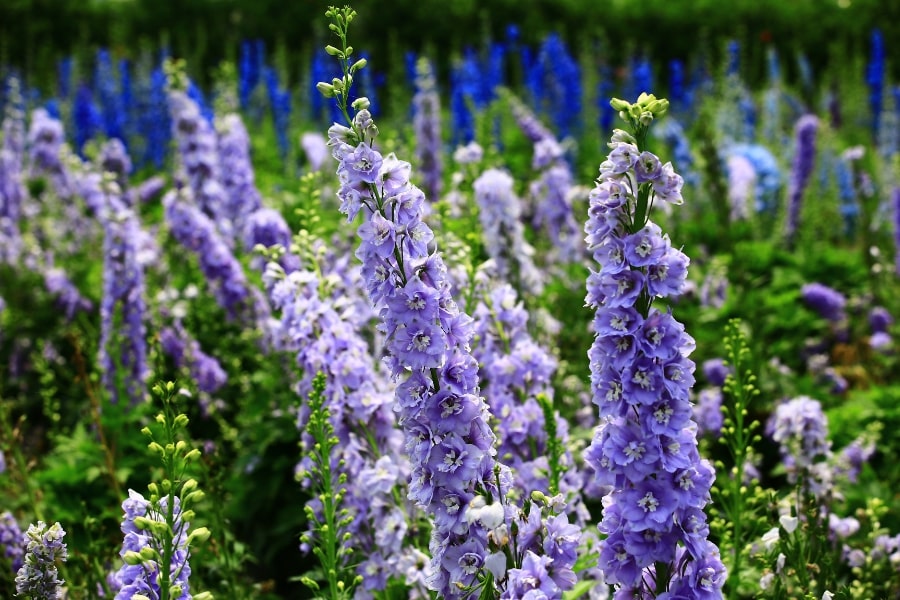Delphinium, commonly known as larkspur, is a genus of perennial flowering plants that belongs to the family Ranunculaceae. The name “Delphinium” is derived from the Greek word “Delphis,” which means dolphin, and refers to the shape of the flower buds, which resemble the nose of a dolphin. There are over 300 species of delphiniums, ranging in size from dwarf plants that are less than a foot tall to towering giants that can reach up to six feet.

Our Selection of Delphinium
At Martin Garden Center, the majority of our Delphinium comes from our regional vendors. Common varieties include the Magic Fountain Series (3-4 varieties) and the Guardian Series (2-3 varieties). After mid Spring, it is unlikely you will find Delphinium as they will have sold out. So buy early, or wait another year.
We are growing 4 varieties of Delphinium in 2025, but we cannot guarantee that we will have them at all times. In addition to the varieties that our regional suppliers will provide us, we will grow:

Growing and Caring For Delphinium
- Site Selection: Choosing the right location is paramount for the success of delphiniums. These plants perform best in full sun but benefit from some afternoon shade, especially in regions with intense heat. Well-draining soil is essential to prevent waterlogging, which can lead to root rot. Amending the soil with organic matter enhances fertility and improves drainage.
- Planting Delphiniums: Plant delphiniums in the spring or fall, giving them time to establish before the extreme temperatures of summer or winter. When planting, dig a hole that accommodates the root ball and provides enough space between plants to encourage good air circulation. Gently loosen the roots before placing the plant in the hole and backfill with soil. Water thoroughly after planting to settle the soil around the roots.
- Watering: Delphiniums appreciate consistently moist soil but dislike standing water. Watering should be regular, especially during dry spells, to keep the soil evenly moist. Avoid overhead watering, as wet foliage can increase the risk of fungal diseases. During periods of prolonged drought, deep watering is essential. Applying a layer of mulch helps retain soil moisture and regulate temperature, contributing to the overall health of the delphiniums.
- Fertilization: Delphiniums are moderate feeders, and applying a balanced, slow-release fertilizer in early spring is usually sufficient. Avoid over-fertilizing, as this can lead to excessive foliage growth at the expense of flower production. A phosphorus-rich fertilizer can promote robust flowering.
- Staking and Support: While captivating, the tall and majestic spikes of delphiniums can be susceptible to wind or heavy rain, leading to bending or breakage. Staking is a crucial aspect of delphinium care. Install sturdy stakes when planting or shortly after growth begins in spring. As the plants grow, use twine or adjustable ties to secure them to the stakes.
- Deadheading: As each flower spike fades, cut it back to a set of healthy leaves or side shoots. This stimulates the production of new blooms and prevents the plant from directing energy towards seed production. Regular deadheading prolongs the flowering season, ensuring delphiniums continue to grace the garden with their spectacular blossoms.
- Disease and Pest Management: Delphiniums can be susceptible to certain pests and diseases, including aphids, slugs, and powdery mildew. Inspect the plants regularly for signs of infestation. Aphids can be controlled with insecticidal soap or by attracting natural predators like ladybugs. Slugs can be deterred with barriers or organic slug control methods. Powdery mildew, a common fungal issue, can be prevented by ensuring good air circulation, proper spacing, and avoiding overhead watering.
- Winter Care: Providing winter protection is essential, especially in regions with harsh winters. Applying a thick layer of mulch around the base of the plants helps insulate the soil and protect the crown from extreme temperatures. In colder climates, cutting back the spent foliage after the first frost and adding a layer of mulch is recommended.
Leaves and Flowers
The foliage forms a lush and attractive backdrop to their towering flower spikes. The deeply lobed leaves, reminiscent of a palm or a fern, add texture and depth to the plant’s overall presentation. These leaves often emerge in a basal rosette, rising from the base of the plant and extending upward along sturdy stems. The foliage can vary in color from vibrant green to rich shades of blue-green, serving as a perfect foil for the vivid hues of the flowers.
Delphinium flowers are renowned for their striking form and captivating colors. The flower spikes, which can reach impressive heights, are adorned with numerous individual blossoms, creating a layered and textured effect. Their petals, known as “spurs,” extend backward and exude sophistication and drama. The central cluster of petals, called the “bee,” provides a focal point, attracting pollinators with its nectar-rich allure. The color range of delphinium flowers spans from pure whites and delicate pastels to rich blues, purples, and even vibrant pinks.

Uses in the Garden
One of the primary and visually stunning uses of Delphiniums in gardens is to introduce striking vertical accents to flower beds. Their tall spikes, adorned with densely packed and vibrant blossoms, create a focal point that draws attention and adds a sense of grandeur to the landscape. Delphiniums are often strategically placed in the middle or rear of flower beds, where their majestic height allows them to stand out against lower-growing companion plants.
Delphiniums are quintessential plants for creating the charm and elegance associated with cottage gardens. Planted alongside other favorites like roses, foxgloves, and hollyhocks, Delphiniums contribute to a whimsical and traditional aesthetic. Their tall spires add vertical interest, while the profusion of colorful blooms contributes to the lush and abundantly flowering character often associated with cottage-style landscapes.
Delphiniums are also prized for their suitability as cut flowers, making them popular for floral arrangements and bouquets. The long, sturdy stems and abundant blossoms of Delphiniums lend themselves well to both formal and informal floral designs. Gardeners often harvest the flower spikes just as the lower florets begin to open, ensuring a longer vase life.

Frequently Asked Questions
Is Delphinium Poisonous?
Delphiniums are toxic and should not be consumed. All parts of the plant contain toxic alkaloids that can cause severe gastrointestinal upset, seizures, and even death if ingested in large quantities. It is also important to wear gloves when handling the plant, as the sap can cause skin irritation.
Is Delphinium a Perennial?
We enjoy Delphiniums as perennials in the Upstate. However, the longevity of Delphiniums can vary based on factors such as local climate, soil conditions, and care provided.
Are Delphiniums Deer Resistant?
Deer are known to graze on delphiniums, especially when other food sources are scarce or if the deer population in the area is high. While the toxicity of delphiniums may deter some animals, it’s not a reliable defense against deer browsing. The lush and tender foliage, as well as the attractive flowers, can be appealing to deer. To protect your delphiniums from deer damage, consider using deer repellents, installing fencing around your garden, or choosing deer-resistant plants for landscaping in deer-prone areas.
